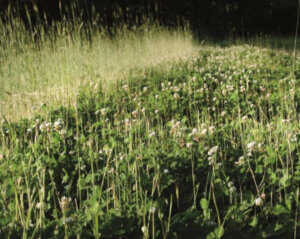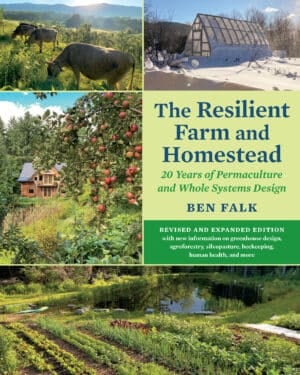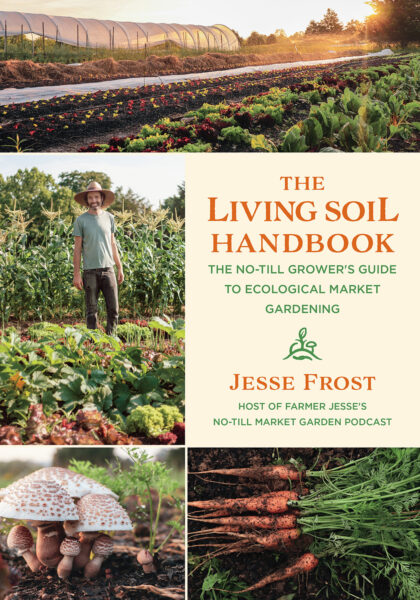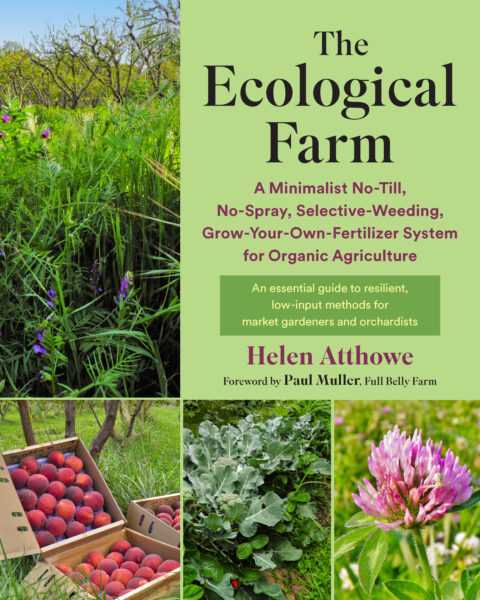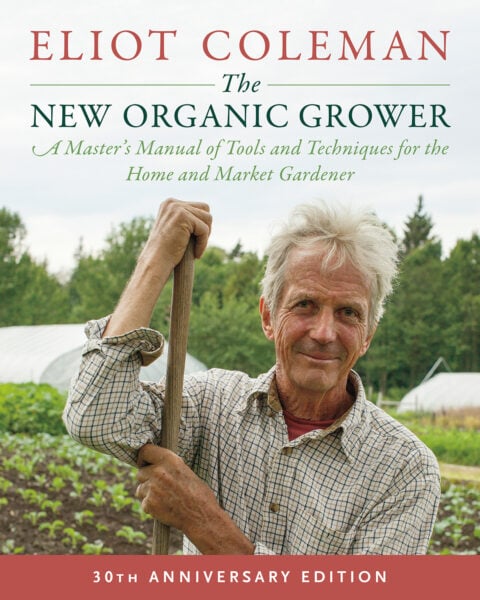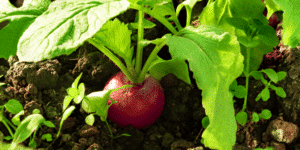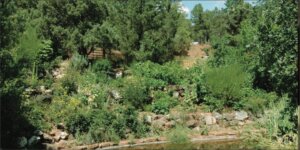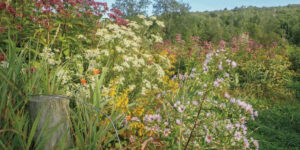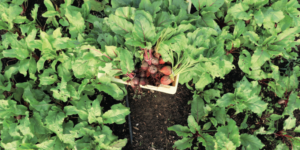Optimize Your Soil with Cover Cropping
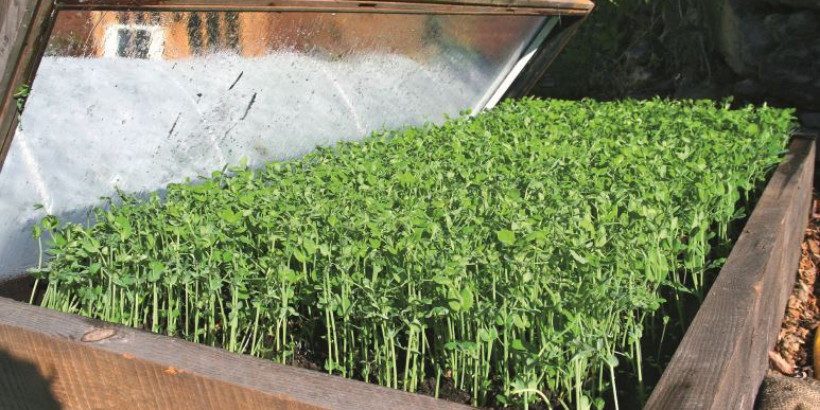
Make use of these slow gardening months by preparing your soil for the year ahead! Cover cropping creates nutrient-rich soil for winter gardening AND provides an extra boost to your seedlings come springtime.
The following is an excerpt from The Resilient Farm and Homestead, Revised and Expanded Edition by Ben Falk. It has been adapted for the web.
Cover Cropping: The Basics
Cover cropping during the growing season, as part of good crop rotation, will probably be considered standard practice in life after the cheap-energy economy.
Our age of peak oil holds a future in which imported growing media and nutrients in the form of soil, manure, and other fertilizers will be increasingly expensive or unavailable.
Cycling fertility on site perpetually will be crucial in a postpeak future and will determine, in large part, the economic success of a farm and the viability of a homestead.
The Importance of Nitrogen
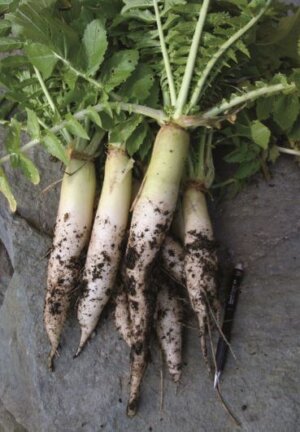
Daikon radish or tillage radish, sown via broadcasting lightly and often through the growing season, especially immediately after heavy grazing and earthwork disturbance.
Since nitrogen is the most often relied upon off-site input, producing (or harvesting) nitrogen on-site via fertility farming will be central.
Indeed, home and farm landscapes in general should be thought of as nitrogencapturing nets, sopping up atmospheric nitrogen and scavenging excess soil nitrogen for plant growth and soil organic matter production.
Nitrogen-fixing plants such as clover, vetch, pea, and myriad perennials are components of this system, as are animals; land committed to these resources represents a significant portion of the productive acreage in a regenerative landscape.
This is why permaculturists are fond of planting at least one nitrogen-fixing plant for every “feeder” plant such as a fruit tree or berry bush.
They serve as the fertility factory in the landscape, reducing or eliminating the need for fertility importing from off-site.
Garden Maintenance: Spreading Mulch
It’s surprising how many organic home gardeners, and even organic farmers, tend their crops carefully throughout the season only to clean out the garden or field at the end of the year and leave exposed earth, spreading not a single pound of cover-crop seed, leaves, straw, hay, or other mulch.
This simple task protects the soil from six months of rain, snow, and wind until the next gardening season.
Without such cover, bare soil loses its finest and best material to the percussion of rain drops, the leaching effect of snow melt, and erosion by wind. In addition, a dormant season planting of cover crops fixes nitrogen and sends organic matter (via roots) into the soil, boosting fertility and soil health for little cost and effort.*
Cover Cropping Strategies
Some covers also aid in optimizing phosphorous, micronutrients, and other chemical levels in the garden. All cover crops contribute organic matter to the soil, the foundation of good soil and plant health.
At WSRF we spread cover crops the day the garden is cleaned out at the end of the season, rake it in if necessary (depending on species), water if needed, and turn in the cover as soon as possible in the spring if it does not suffer winterkill.
Buckwheat is one of my favorite covers (though it doesn’t fix nitrogen), because in my climate it winterkills reliably.
While we have not dialed in a nearly perfect covercropping strategy, we have found that the following principles, when followed, result in consistent winter cover of our beds. Truly, the challenge is dealing with the cover (turning it in/grazing it down) in the spring.
Creating A Cover
Sow a cover as soon as possible after cleaning the bed—crucial to get ahead of any weeds. We like to harvest, graze the bed very hard with chickens, then pull any remaining weeds with their roots and rake in a cover crop—especially oats or buckwheat.
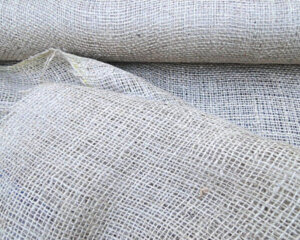 Use whatever is at hand for cover. We cover garden beds with tarps, membranes from pond work (EPDM works great), burlap, or simply mulch beds heavily in the fall to get a solid winter cover.
Use whatever is at hand for cover. We cover garden beds with tarps, membranes from pond work (EPDM works great), burlap, or simply mulch beds heavily in the fall to get a solid winter cover.
This covering—but not cover cropping—has the advantage of protecting the bed from erosion while leaving you with a nice bare planting surface or seed bed in the spring but with the distinct disadvantage of no C and N capture and organic matter building as a result.
Straw: To Use Or Not to Use?
We are not zealots about using only straw for mulch. I’ve seen as much “weed” come up from straw as from hay, and the idea that hay isn’t clean but straw is is simply not true where I live.
Straw is also not available locally here, as almost no one grows grain. I now make my own straw via the rice production, but that is not enough to mulch many beds heavily, though I am using it along with rice hulls as mulch and having great results.
Sheet Mulching & Composting
Turn the cover in early, or if you have enough materials, sheet mulch it. By “early” I do not mean necessarily when snow melts, but it should be done as early as is needed to kill the cover crop before you need to seed or plant the bed.
When establishing new beds we will devote the resources needed to actually mulch each spring for one or two springs. This takes a lot of material but results in rapid bed formation.
This looks like the following:
- Sheet mulch an area (usually grass) to kill existing vegetation using cardboard, burlap, straw, hay (we avoid newspaper due to the dyes and other likely chemicals).
- Add compost on top.
- Plant in that in year one—ideally, beans or other fast soil-builders and light feeders.
- Cover crop it heavily in the late summer or fall.
- Sheet mulch that cover crop the following spring, and repeat compost application.
I should note that this is one area of farm/homestead work in which we find that chickens have a distinct advantage over every other form of livestock we’ve tried (the other is in disturbing groundcovers to create seedbeds in pasture—essentially the same effect).
We use sheep to graze down a really weedy bed and the ducks to keep snails and slugs out, but with their immense scratching effect, only chickens will truly turn over the bed, wreck all or most of the weeds, create a perfect seedbed, and fertilize the bed simultaneously.
Turkeys would likely have a similarly positive disturbance, but we have not tried them yet.
Permanent Covers in Vegetable Beds
An additional aspect of cover cropping that we have found some success with (but that seems to have even greater promise over time) is successional planting of vegetables through a cover crop—à la Masanobu Fukuoka* style.
This approach involves seeding a crop such as squash, cucumber, tomato, kale, or most anything else that tends to leave a lot of open bed space or bare soil between plants for a large period of time during its establishment.
These crops create major weed and soil-damage problems because they encourage so much bare soil for such long durations.
Avoiding Damage: Planting Timelines
To avoid this we have tried planting buckwheat a few weeks after the squash or other vegetable gets established.
Giving the squash a head start allows it, in theory, to get above the cover crop, before the cover then comes in behind it to fill out the bare soil.
We have had this work to a functional but not nearly optimal degree.
The cover crop (especially buckwheat) tends to get too high and shade the main crop too much.
Ideally, we would use a very low-growing cover that can be broadcasted, is easy and cheap to make or acquire, is fast establishing, and is nitrogen fixing.
Ideally, the seed could take a bit of shade as well.
The Ideal Seed for Cover Cropping
This ideal seed would be something like white clover but much faster establishing and not perennial. White clover is a perfect plant in many respects, but it’s slow to establish.
I’d like to try to maintain garden beds of permanent white clover, like Fukuoka did in his rice paddies, and also grow vegetables through the clover cover. It would likely require planting somewhat large and vigorous seedlings into the clovered bed, but that seems doable.
The challenge in this approach would be the constant need to seed clover, as other plants come in constantly, and keeping the other taller grasses and other “weeds” out of the bed.
In our climate I am not sure that the perfect groundcover for permanent cover in vegetable beds exists, but I will keep looking for one.
The need for a successional cover to bolster crops is crucial to protecting and building soil while working an annual system. Much work needs to be done to improve this area of home and farm soil maintenance and enhancement.
Watch author Ben Falk explain cover cropping in his skill share webinar.
Notes
*It takes time for a nitrogen-fixing plant to actually convert atmospheric N into soil N, so turning an N-fixing cover crop in before this process happens is a common mistake.
*Masanobu Fukuoka was a renowned farm innovator living in Japan. His experiments with “natural farming” and a particularly Taoist approach of letting nature do as much as possible—a lot like permaculture—received international acclaim over the years as his success in growing high yields with minimal inputs was astounding. I regard him as a particularly important reference because of the nuanced way in which he practiced successional plantings.
Recommended Reads
https://www.chelseagreen.com/2023/weed-suppression/
Recent Articles
Searching for tips on how to grow healthy plants? The excerpt below offers advice on how to improve your farm or garden’s immune system through providing optimal conditions, managing plant competition, and achieving optimal nutrient balance. The following is an excerpt from The Ecological Farm by Helen Atthowe. It has been adapted for the web.…
Read MoreGet ready to create your own seven-layer forest garden! Food forests, or edible forest gardens, are life-filled places that provide habitat for wildlife and food for humans while promoting natural beauty and biodiversity. To get started, all you need is to take a page from Mother Nature’s book. The following is an excerpt from Gaia’s…
Read MoreInvasive plants creeping into your yard is frustrating. Particularly for thistle, there’s a better approach than yanking it out at the root or worse spraying herbicide. Work smarter, not harder, with these approaches to removing invasive thistle. The following are excerpts from Beyond the War on Invasive Species by Tao Orion and The Wild Wisdom of…
Read MorePicture-perfect farms may be aesthetically pleasing, but they’re likely lacking in biodiversity. Rewilding practices allow the land to return to its natural wild state, providing more room for fruit-bearing plants to grow and animals to control small pests. The following is an excerpt from Farming on the Wild Side by Nancy J. Hayden and John…
Read MoreLet’s drop the beet! Beets can be grown year-round and are a perfect, flavorful addition to meals. Get started on growing your own no-till beets with help from these tips! The following is an excerpt from The Living Soil Handbook by Jesse Frost. It has a been adapted for the web. How to Grow No-Till…
Read More
